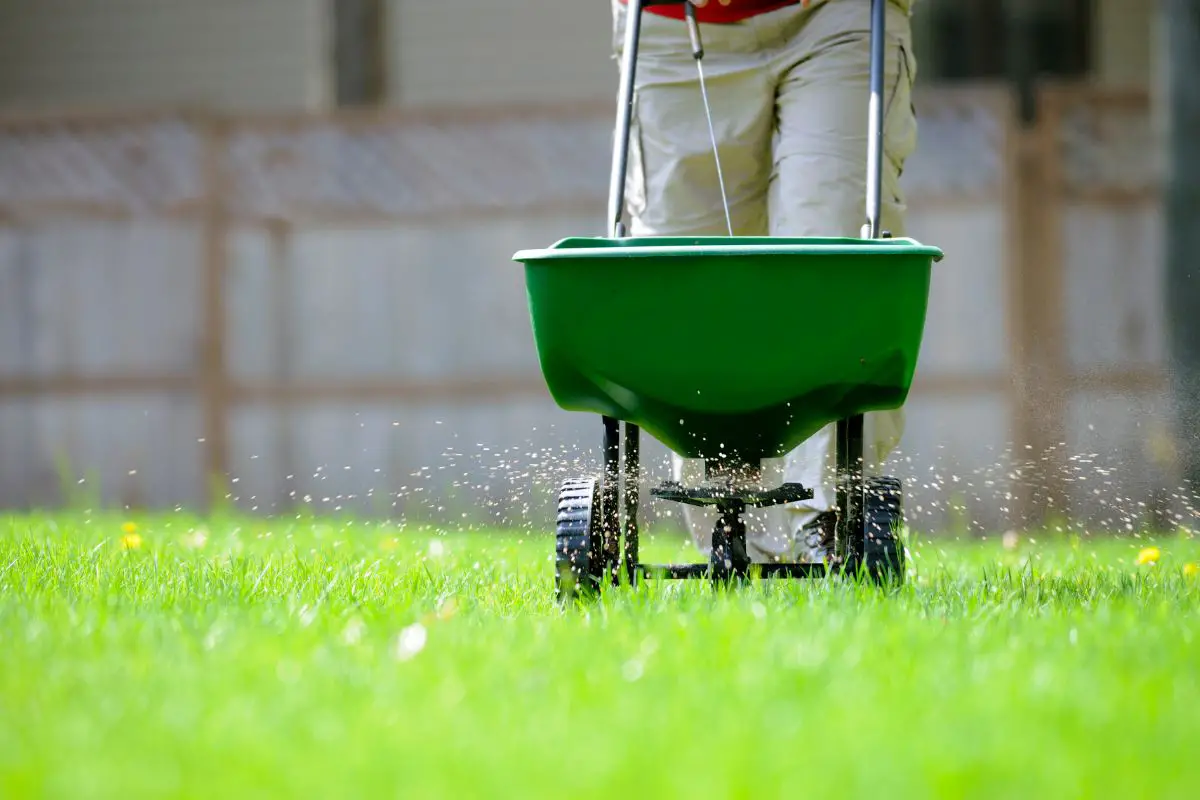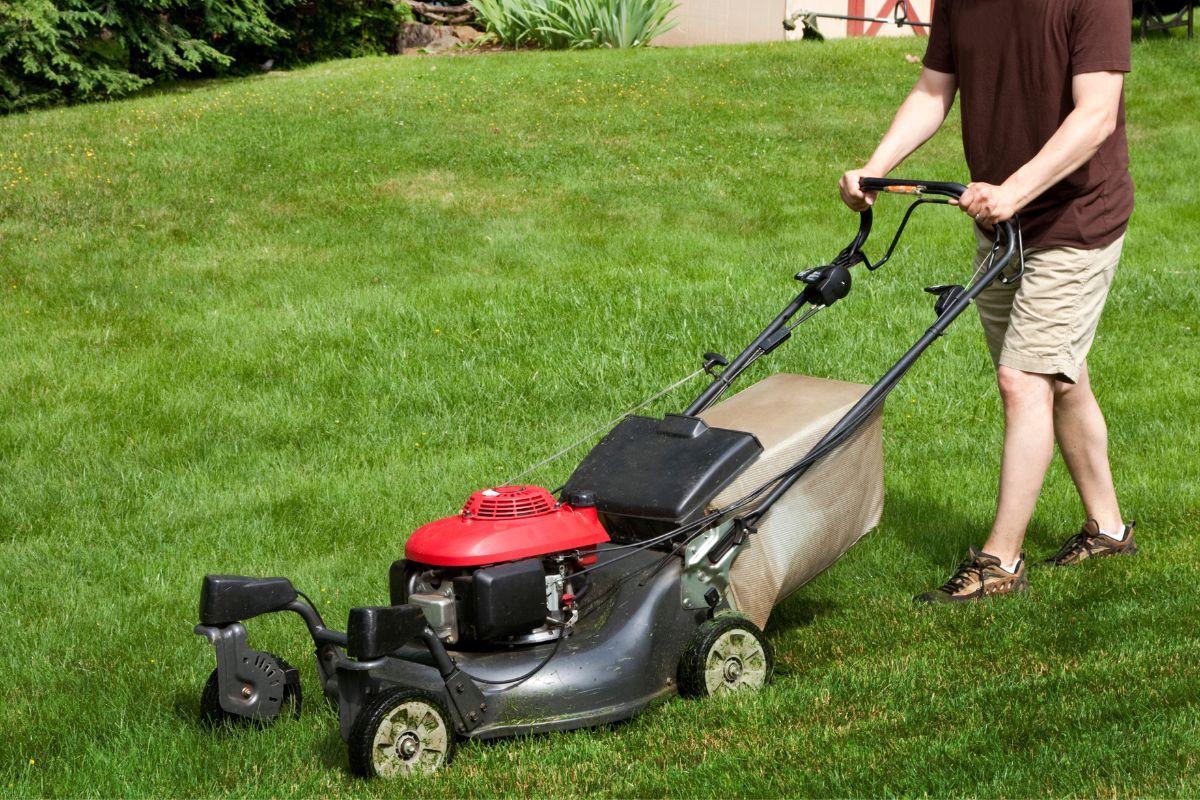A warm spring day is a perfect opportunity to get some chores done outside in your yard. This usually involves having a bit of cleaning after the winter months, and of course taking care of your lawn.
To get the best lawn you can for summer now is the best time to both mow and fertilize the grass.
What step should come first? Keep reading to find out how to fertilize and mow your lawn so that it’s picture-perfect for future summer garden parties.
Mowing And Fertilizing – What Comes First
You can fertilize your lawn and cut the grass on the same day with no issue, but you should always make sure to fertilize the grass AFTER you have cut it, not before.
Fertilizers that come in a granular form will dry up much more slowly than liquid ones. No matter which type you use though, applying fertilizer a few days after you mow the grass will help it to comply and absorb into the soil and grass.
You can add it a few hours after mowing to get everything done on the same day, but waiting a few days gives you the best results.
In most cases, fertilization of the grass is most beneficial when applied in the early stages of spring, late summer, or early autumn.
Fertilizing the lawn first and then mowing it won’t make your lawn dry up and die or anything like that, it just makes the fertilizer much less effective.
How To Use Fertilizer
Follow these 6 easy steps to make the most out of your fertilizer when spreading it on your lawn.

1. Check The Weather
If it’s going to rain in the next few days, then it’s best to wait until this passes before starting as the rain would wash away the fertilizer.
2. Clean The Lawn
Gather up any debris, including branches or leaves that may be found in the yard. Remove any obstacles, including garden ornaments, outdoor furniture, and yard decor.
3. Cut The Grass
Before you do this, the grass must be completely dry. Wet grass can make cutting it a lot harder, especially if it’s very long and overgrown.
Insects, snakes, mice, and voles are also more likely to enter an area with long grass, so be sure to keep an eye out for these little critters.
You should aim to cut the grass to a length of between two and three inches, depending on what kind of lawn mower you have and its various settings.
When grass is cut shorter, it is more susceptible to damage from drought, heat, and weed invasion, but with the right fertilizer, all of this can be prevented.
If you’ve cut your grass and there are a lot of loose clippings clumped together all over the lawn, then the fertilizer won’t be able to penetrate the soil.
To get these bits up, either rake your lawn or use an attachment on your mower to gather up these clumps.
4. Aerating The Soil – Optional
When the grass is actively growing, which is often in the spring or early fall, aerating the soil will help to further open up the ground for accepting fertilizing.
This is because aeration helps to break up compacted soil, so the fertilizer can soak through easier. To make this princess quicker, use a spike aerator or a plug.
How long you should aerate your soil will be based on many factors, including the usage of manual aerating tools or an attachment for a riding mower, as well as the size of your yard.
You can give the grass several days’ worth of watering before beginning this step to help the process as well. The soil can be made more porous and better able to take in nutrients if it’s a tiny bit damp.
5. Apply Fertilizer To The Lawn
The use of fertilizer encourages rapid and healthy growth in the grass, which in turn makes the grass stronger and the lawn more resistant to the growth of weeds.
Heavy rainfall is absorbed by healthy grassroots, which helps to keep lawn areas from becoming flooded.
Make sure the fertilizer you choose has been approved for use on grass. There are many different combinations of nitrogen (N), phosphorus (P), and potassium (K) that can be found in fertilizers.
The grass might be “burned” if there is an excessive amount of nitrogen in particular, which will kill the lawn and stop growth.
6. Wait For A Few Days Then Mow Again
Always make sure to follow the instructions on the fertilizer’s package, especially about how long it needs to dry. In most cases, this takes anywhere from a few hours to two days.
It takes some time for the nitrogen, phosphorus, and potassium in the fertilizer to work their way down into the soil and be absorbed by the grassroots.
If you cut your grass too soon, this process will stop, but you shouldn’t wait more than a week or the grass will get too long.
Summary
If you want to cut the grass and fertilize the lawn on the same day, you should always cut the grass first. This will make sure that the grass is able to completely absorb and hold the nutrients that are provided by the fertilizer.
You should get the lawn ready in advance by checking the forecast to make sure it will be dry, removing any debris from the lawn, mowing the grass, and then sweeping up the grass cuttings.
The condition of the grass will then be ideal for receiving and absorbing the nutrients that are provided by fertilizer.
To reduce nitrogen burn and promote absorption, liquid or granular forms of fertilizer are typically applied along with water, but always follow the instructions on your particular fertilizer.
It’s strongly suggested that you wait at least 24 hours before mowing the lawn again.
Lawns that have been fertilized will have fewer weeds, insects, and small rodents than lawns that have not been fertilized, which is one of the main benefits of doing this. Grass will also grow stronger and greener thanks to the fertilizer.


